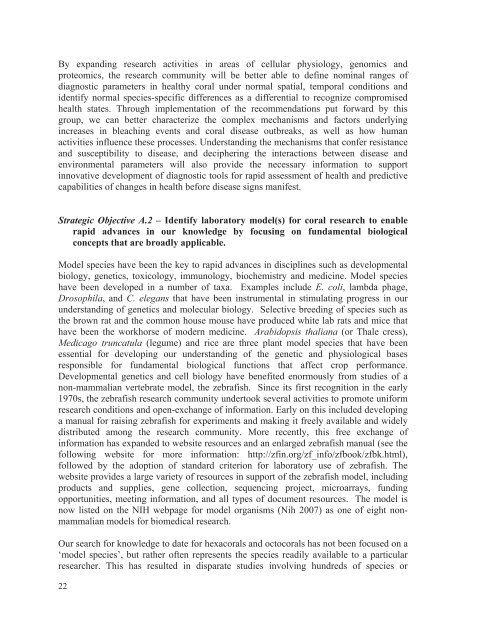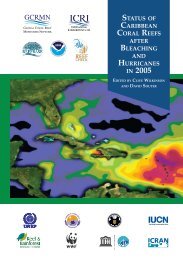Coral Health and Disease in the Pacific: Vision for Action
Coral Health and Disease in the Pacific: Vision for Action
Coral Health and Disease in the Pacific: Vision for Action
You also want an ePaper? Increase the reach of your titles
YUMPU automatically turns print PDFs into web optimized ePapers that Google loves.
By exp<strong>and</strong><strong>in</strong>g research activities <strong>in</strong> areas of cellular physiology, genomics <strong>and</strong>proteomics, <strong>the</strong> research community will be better able to def<strong>in</strong>e nom<strong>in</strong>al ranges ofdiagnostic parameters <strong>in</strong> healthy coral under normal spatial, temporal conditions <strong>and</strong>identify normal species-specific differences as a differential to recognize compromisedhealth states. Through implementation of <strong>the</strong> recommendations put <strong>for</strong>ward by thisgroup, we can better characterize <strong>the</strong> complex mechanisms <strong>and</strong> factors underly<strong>in</strong>g<strong>in</strong>creases <strong>in</strong> bleach<strong>in</strong>g events <strong>and</strong> coral disease outbreaks, as well as how humanactivities <strong>in</strong>fluence <strong>the</strong>se processes. Underst<strong>and</strong><strong>in</strong>g <strong>the</strong> mechanisms that confer resistance<strong>and</strong> susceptibility to disease, <strong>and</strong> decipher<strong>in</strong>g <strong>the</strong> <strong>in</strong>teractions between disease <strong>and</strong>environmental parameters will also provide <strong>the</strong> necessary <strong>in</strong><strong>for</strong>mation to support<strong>in</strong>novative development of diagnostic tools <strong>for</strong> rapid assessment of health <strong>and</strong> predictivecapabilities of changes <strong>in</strong> health be<strong>for</strong>e disease signs manifest.Strategic Objective A.2 – Identify laboratory model(s) <strong>for</strong> coral research to enablerapid advances <strong>in</strong> our knowledge by focus<strong>in</strong>g on fundamental biologicalconcepts that are broadly applicable.Model species have been <strong>the</strong> key to rapid advances <strong>in</strong> discipl<strong>in</strong>es such as developmentalbiology, genetics, toxicology, immunology, biochemistry <strong>and</strong> medic<strong>in</strong>e. Model specieshave been developed <strong>in</strong> a number of taxa. Examples <strong>in</strong>clude E. coli, lambda phage,Drosophila, <strong>and</strong> C. elegans that have been <strong>in</strong>strumental <strong>in</strong> stimulat<strong>in</strong>g progress <strong>in</strong> ourunderst<strong>and</strong><strong>in</strong>g of genetics <strong>and</strong> molecular biology. Selective breed<strong>in</strong>g of species such as<strong>the</strong> brown rat <strong>and</strong> <strong>the</strong> common house mouse have produced white lab rats <strong>and</strong> mice thathave been <strong>the</strong> workhorse of modern medic<strong>in</strong>e. Arabidopsis thaliana (or Thale cress),Medicago truncatula (legume) <strong>and</strong> rice are three plant model species that have beenessential <strong>for</strong> develop<strong>in</strong>g our underst<strong>and</strong><strong>in</strong>g of <strong>the</strong> genetic <strong>and</strong> physiological basesresponsible <strong>for</strong> fundamental biological functions that affect crop per<strong>for</strong>mance.Developmental genetics <strong>and</strong> cell biology have benefited enormously from studies of anon-mammalian vertebrate model, <strong>the</strong> zebrafish. S<strong>in</strong>ce its first recognition <strong>in</strong> <strong>the</strong> early1970s, <strong>the</strong> zebrafish research community undertook several activities to promote uni<strong>for</strong>mresearch conditions <strong>and</strong> open-exchange of <strong>in</strong><strong>for</strong>mation. Early on this <strong>in</strong>cluded develop<strong>in</strong>ga manual <strong>for</strong> rais<strong>in</strong>g zebrafish <strong>for</strong> experiments <strong>and</strong> mak<strong>in</strong>g it freely available <strong>and</strong> widelydistributed among <strong>the</strong> research community. More recently, this free exchange of<strong>in</strong><strong>for</strong>mation has exp<strong>and</strong>ed to website resources <strong>and</strong> an enlarged zebrafish manual (see <strong>the</strong>follow<strong>in</strong>g website <strong>for</strong> more <strong>in</strong><strong>for</strong>mation: http://zf<strong>in</strong>.org/zf_<strong>in</strong>fo/zfbook/zfbk.html),followed by <strong>the</strong> adoption of st<strong>and</strong>ard criterion <strong>for</strong> laboratory use of zebrafish. Thewebsite provides a large variety of resources <strong>in</strong> support of <strong>the</strong> zebrafish model, <strong>in</strong>clud<strong>in</strong>gproducts <strong>and</strong> supplies, gene collection, sequenc<strong>in</strong>g project, microarrays, fund<strong>in</strong>gopportunities, meet<strong>in</strong>g <strong>in</strong><strong>for</strong>mation, <strong>and</strong> all types of document resources. The model isnow listed on <strong>the</strong> NIH webpage <strong>for</strong> model organisms (Nih 2007) as one of eight nonmammalianmodels <strong>for</strong> biomedical research.Our search <strong>for</strong> knowledge to date <strong>for</strong> hexacorals <strong>and</strong> octocorals has not been focused on a‘model species’, but ra<strong>the</strong>r often represents <strong>the</strong> species readily available to a particularresearcher. This has resulted <strong>in</strong> disparate studies <strong>in</strong>volv<strong>in</strong>g hundreds of species or22
















